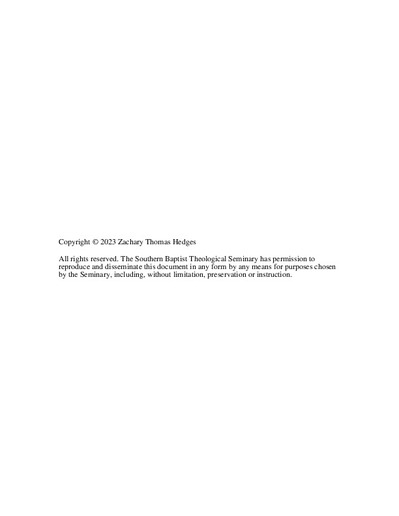| dc.description.abstract | This study examines the use of the covenant concept in second-century texts that address three primary social and rhetorical contexts for early Christian identity formation: Judaism, Greco-Roman culture, and heterodoxy. It argues that leading Christian writers consistently developed and applied a notion of the church as the new covenant community by interpreting scriptural sources through the lens of christological assumptions, which they used to characterize the covenant community’s identity in the areas of belief, ritual, and practice.
Chapter 1 notes the absence of the covenant idea as a major element in recent scholarly discussion of early Christian identity formation and also reviews the history of scholarship on the covenant concept itself, which has been analyzed in both biblical studies and historical theology, in addition to select studies of individual writers (though rarely in connection with identity formation).
Chapter 2 surveys the first of two important background contexts for understanding early Christian use of the covenant concept—its use and development within Judaism, including the Old Testament, apocryphal and pseudepigraphal literature of Second Temple Judaism, and the Dead Sea Scrolls. It also briefly examines the New Testament usage in the Synoptic Gospels, Paul, and epistle to the Hebrews.
Chapter 3 turns to the Greco-Roman context and notes the absence of the covenant concept as a significant category of identity there, and explores possible parallels to it in the religious and social realms. It also notes the lack of usage within diverse “Gnostic” movements and the mis-use, from the perspective of orthodox writers, within Marcion’s theological system.
Chapter 4 introduces three chapters analyzing the orthodox Christian use of the covenant concept, beginning with the dialogue with Judaism, which also regarded it as an essential category of collective identity, and derived it from the same sources, the Old Testament scriptures. Though retaining Judaism’s basic covenantal logic and structure, such Christian texts as the Epistle of Barnabas, Justin Martyr’s Dialogue with Trypho, and Tertullian of Carthage’s Against the Jews redefine these features in christological terms to develop the notion of a distinctly christological new covenant community.
Chapter 5 examines the ways in which apologetically-oriented writers redeployed these covenantal concepts in engaging Greco-Roman culture—for example, by identifying Christ as logos and nomos. The Apologies of Justin Martyr and Aristides of Athens and Clement of Alexandria’s Exhortation to the Greeks follow the precedent of the Preaching of Peter in presenting Christ as the New Law and portraying the new covenant community as a “third race” that fulfills and transcends the ideals of earlier Hebrew and Greek philosophical traditions.
Chapter 6 focuses on the “internal” application of the covenant concept to the church’s struggle with heterodox movements, which either lacked or mis-used covenant schemes in articulating identities grounded in false doctrines. Among heresiological writers, Irenaeus of Lyons defends the unified redemptive-historical narrative that results from a christological understanding of the covenants (Against Heresies; Epideixis), while Clement of Alexandria utilizes the covenant concept for the moral formation of the orthodox community (Christ the Pedagogue) and applies it to Greek philosophy as a parallel concept to the Mosaic law among Gentiles (Miscellanies). Finally, Tertullian of Carthage uses it to argue, like Irenaeus, for the unity of Scripture against Marcionites (Against Marcion), and also grounds his anti-monarchian Trinitarian theology in a proper understanding of the new covenant economy (Against Praxeas).
Chapter 7 summarizes the findings of chapters 4–6 and offers a synthetic portrait of the new covenant idea among Christian writers of the second century, noting its leading characteristics in the identity-forming areas of belief/narrative (redemptive history and the rule of faith), ritual (baptism and the Eucharist), and ethics (the Two Ways tradition and the Law/Spirit dichotomy). The conclusion suggests some possible implications for contemporary scholarly discussions and avenues for further research. | en_US |

